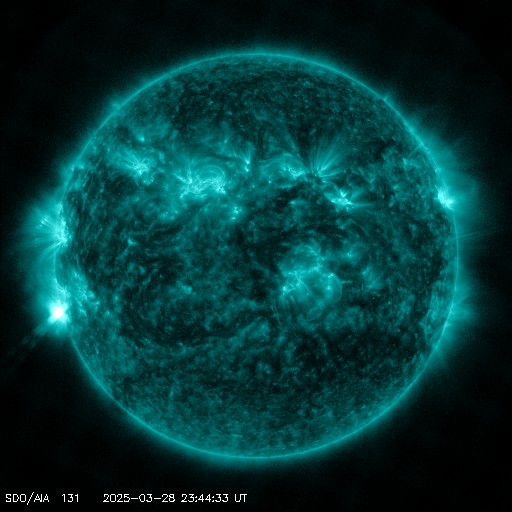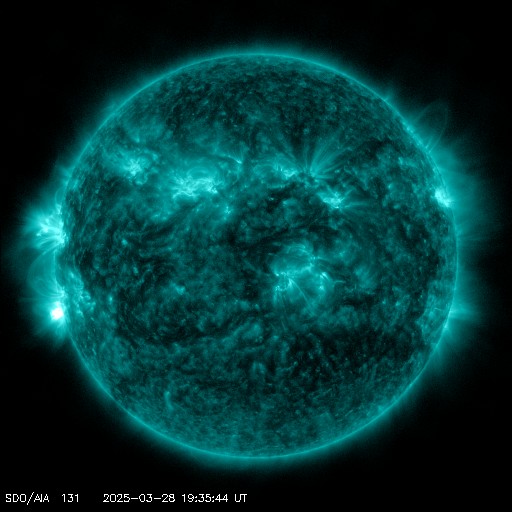Viewing archive of Tuesday, 21 August 2001
Solar activity report
Any mentioned solar flare in this report has a scaling factor applied by the Space Weather Prediction Center (SWPC). Because of the SWPC scaling factor, solar flares are reported as 42% smaller than for the science quality data. The scaling factor has been removed from our archived solar flare data to reflect the true physical units.
Report of Solar-Geophysical Activity 2001 Aug 21 2200 UTCPrepared by the NOAA © SWPC and processed by SpaceWeatherLive.com
Joint USAF/NOAA Report of Solar and Geophysical Activity
SDF Number 233 Issued at 2200Z on 21 Aug 2001IA. Analysis of Solar Active Regions and Activity from 20-2100Z to 21-2100Z
Solar activity remained low. Region 9585 (N15E11)
produced isolated subflares, none of which were associated with
significant X-ray emission. New Region 9591 (S18E71) rotated into
view. It was the likely source for a bright surge near SE19 at
21/1050 UTC. A filament erupted from the southwest quadrant around
mid-period. The eruption was associated with a long-duration C2
X-ray event that peaked at 21/1303 UTC and a coronal mass ejection
that did not appear to be Earth directed.
IB. Solar Activity Forecast
Solar activity is expected to be at
low to moderate levels. There will be a fair chance for an isolated
M-class flare during the period.
IIA. Geophysical Activity Summary 20-2100Z to 21-2100Z
Geomagnetic field activity ranged from quiet to active levels.
Activity increased to unsettled to active levels after 21/0900 UTC.
The greater than 10 MeV proton flux remained slightly enhanced and
gradually decreased toward background in the wake of the proton
event of 16 - 18 August.
IIB. Geophysical Activity Forecast
Geomagnetic field activity is
expected to be at quiet to unsettled levels during most of the
period.
III. Event Probabilities 22 Aug to 24 Aug
| Class M | 30% | 30% | 30% |
| Class X | 05% | 05% | 05% |
| Proton | 01% | 01% | 05% |
| PCAF | green | ||
IV. Penticton 10.7 cm Flux
Observed 21 Aug 160 Predicted 22 Aug-24 Aug 165/170/175 90 Day Mean 21 Aug 152
V. Geomagnetic A Indices
Observed Afr/Ap 20 Aug 006/010 Estimated Afr/Ap 21 Aug 014/016 Predicted Afr/Ap 22 Aug-24 Aug 012/010-010/010-012/012
VI. Geomagnetic Activity Probabilities 22 Aug to 24 Aug
| A. Middle Latitudes | |||
|---|---|---|---|
| Active | 25% | 20% | 20% |
| Minor storm | 10% | 10% | 10% |
| Major-severe storm | 01% | 01% | 01% |
| B. High Latitudes | |||
|---|---|---|---|
| Active | 30% | 25% | 25% |
| Minor storm | 15% | 15% | 15% |
| Major-severe storm | 01% | 01% | 01% |
All times in UTC
Current data suggests there is a slight possibility for aurora to appear at the following high latitude regions in the near future
Murmansk, VorkutaLatest news
Latest forum messages
AR4046 127Incoming & Unnumbered Active Regions 1657Aurora photography hints for those of us with smartphones 49Large Coronal Hole 25 178LASCO Data Not Updating 5
More topicsSupport SpaceWeatherLive.com!
A lot of people come to SpaceWeatherLive to follow the Sun's activity or if there is aurora to be seen, but with more traffic comes higher server costs. Consider a donation if you enjoy SpaceWeatherLive so we can keep the website online!

Latest alerts
00:00 UTC - Solar flare
Moderate M1.79 flare
Friday, 28 March 2025
23:36 UTC - Radio Blackout
Minor R1 radio blackout in progress (≥M1 - current: M1.04)
21:24 UTC - Hemispheric Power Index
The OVATION model predicts the Hemispheric Power Index to reach 51GW at 21:59 UTC
19:45 UTC - Solar flare
Moderate M1.16 flare
19:27 UTC - Radio Blackout
Minor R1 radio blackout in progress (≥M1 - current: M1.1)
Space weather facts
| Last X-flare | 2025/03/28 | X1.1 |
| Last M-flare | 2025/03/28 | M1.7 |
| Last geomagnetic storm | 2025/03/27 | Kp5 (G1) |
| Spotless days | |
|---|---|
| Last spotless day | 2022/06/08 |
| Monthly mean Sunspot Number | |
|---|---|
| February 2025 | 154.6 +17.6 |
| March 2025 | 128.3 -26.4 |
| Last 30 days | 128.3 -23.7 |




